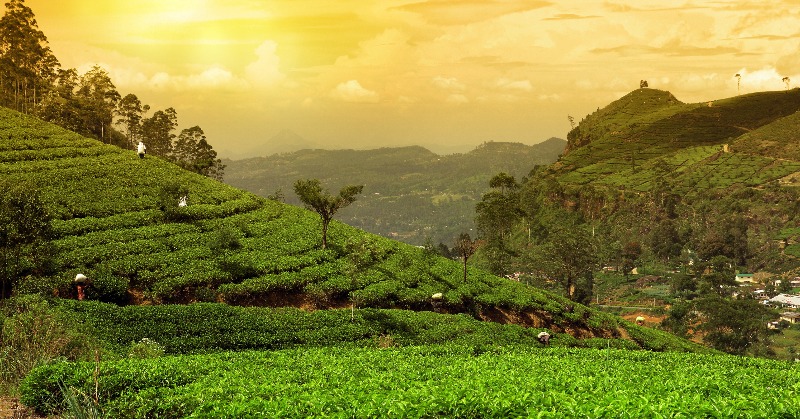Is Darjeeling Tea Production In Crisis? Examining Current Concerns

Table of Contents
Climate Change and its Impact on Darjeeling Tea Gardens
The unpredictable nature of climate change significantly impacts Darjeeling tea gardens. Fluctuating temperatures and erratic rainfall patterns directly affect the quality and quantity of tea leaves produced.
Shifting weather patterns and their effects on tea bushes:
- Increased frequency of unpredictable rainfall: This leads to waterlogging, hindering proper tea bush growth and impacting the quality of the leaves, resulting in lower yields and a less desirable final product. The delicate balance needed for optimal Darjeeling tea production is easily disrupted.
- Higher temperatures leading to premature withering: Increased heat accelerates the withering process, reducing the time for the leaves to develop their characteristic flavor compounds. This results in a less aromatic and flavorful cup of tea. The iconic muscatel flavor, so prized in Darjeeling tea, is particularly vulnerable.
- Pest and disease outbreaks exacerbated by changing climatic conditions: Warmer temperatures and altered humidity levels create ideal breeding grounds for pests and diseases, damaging tea bushes and requiring increased pesticide use, potentially impacting the organic certification of many Darjeeling tea gardens.
Adapting to climate change in Darjeeling tea cultivation:
The industry is actively seeking solutions to mitigate the effects of climate change on Darjeeling tea production. These include:
- Exploring drought-resistant tea varieties: Research and development are focusing on cultivating tea plants that are more resilient to drought conditions, ensuring consistent yields even with reduced rainfall.
- Implementing sustainable water management techniques: Efficient irrigation systems and water harvesting methods are being adopted to optimize water usage and reduce reliance on unpredictable rainfall.
- Investing in climate-resilient agricultural practices: This includes techniques such as agroforestry and soil conservation to improve the overall resilience of the tea gardens to climate change impacts.
Labor Shortages and the Aging Workforce in Darjeeling Tea Plantations
The Darjeeling tea industry faces a severe labor shortage, compounded by an aging workforce. Attracting younger generations to the plantations is a major hurdle.
The challenge of attracting younger generations to tea farming:
- Lack of attractive wages and working conditions: Many young people find the wages and working conditions in tea gardens unattractive compared to opportunities in urban areas. This leads to a lack of skilled workers for the entire process, from plucking to processing.
- Migration of younger workers to urban areas seeking better opportunities: The allure of better-paying jobs and improved living standards in cities drives younger generations away from traditional tea farming. This exodus threatens the continuity of Darjeeling tea production skills.
- Difficulty in attracting skilled labor for tea processing and manufacturing: The complex processes involved in producing high-quality Darjeeling tea require skilled labor. The shortage of skilled workers impacts the overall quality and consistency of the final product.
Solutions for attracting and retaining workers in the Darjeeling tea industry:
Addressing this labor crisis requires a multi-pronged approach:
- Improving wages and benefits packages: Offering competitive wages and benefits, including healthcare and housing, can attract and retain workers.
- Investing in training and skill development programs: Providing opportunities for skill enhancement and career advancement can make the tea industry a more attractive career path.
- Promoting the benefits of working in the Darjeeling tea industry: Highlighting the cultural significance and the pride associated with producing world-renowned Darjeeling tea can attract young people seeking meaningful work.
Competition from other Tea-Producing Regions
Darjeeling tea faces stiff competition from other tea-producing regions globally. The lower production costs in these regions pose a significant challenge to the premium pricing of Darjeeling tea.
The rise of large-scale tea production in other regions:
- Increased competition from cheaper tea produced in other countries: Large-scale tea production in countries with lower labor costs and production expenses presents a considerable challenge to the economic viability of Darjeeling tea.
- Challenges in maintaining the premium price point for Darjeeling tea: The increasing competition necessitates innovative strategies to justify and maintain the higher price point associated with Darjeeling tea's unique qualities.
- The need to differentiate Darjeeling tea based on its unique qualities and terroir: Highlighting the unique terroir, the specific geographical and environmental factors contributing to Darjeeling tea’s distinct flavor profile, is vital for maintaining its market position.
Strategies to maintain a competitive edge for Darjeeling tea:
To combat this competition, the Darjeeling tea industry needs to focus on:
- Emphasis on superior quality and authenticity: Maintaining the highest standards of quality and ensuring authenticity through strict quality control measures is crucial.
- Strengthening brand identity and promoting Darjeeling tea's unique characteristics: Effective marketing campaigns emphasizing the unique taste and origin of Darjeeling tea are necessary to build a strong brand identity.
- Exploring niche markets and higher value product segments: Targeting niche markets with specialized Darjeeling tea blends and focusing on higher value segments, such as single-estate teas, can enhance profitability.
The Impact of Pests and Diseases on Darjeeling Tea Production
Pests and diseases pose a constant threat to Darjeeling tea production, impacting both the yield and quality of the tea.
Common pests and diseases affecting Darjeeling tea bushes:
- Blister blight, red spider mites, and other fungal infections: These pests and diseases can significantly reduce tea yields and compromise the quality of the leaves, affecting the final product's flavor and appearance.
- Impact of these infestations on tea yield and quality: Infestations lead to lower yields and a reduction in the quality of the tea produced, impacting both the taste and aroma.
- The cost of pest and disease management in Darjeeling tea gardens: Controlling pests and diseases requires significant investment in pesticides and other control measures, adding to the overall cost of production.
Sustainable pest and disease management strategies:
Sustainable practices are crucial for controlling pests and diseases while minimizing environmental impact:
- Integrated Pest Management (IPM) techniques: IPM combines various methods to control pests and diseases, minimizing the use of chemical pesticides.
- Biopesticides and organic methods of pest control: Utilizing biopesticides and organic methods reduces reliance on harmful chemical pesticides, enhancing the sustainability and environmental friendliness of Darjeeling tea production.
- Research and development of disease-resistant tea varieties: Investing in research to develop tea varieties that are naturally resistant to common pests and diseases is crucial for long-term sustainability.
Conclusion
The future of Darjeeling tea production is undeniably challenged. Climate change, labor shortages, intense competition, and pest and disease outbreaks threaten its sustainability. However, by adopting proactive adaptation strategies, investing in sustainable practices, and emphasizing quality and brand identity, the unique legacy of Darjeeling tea can be preserved. By prioritizing innovation and collaboration, we can ensure the continued production of this exquisite beverage for generations to come. Let’s work together to protect the future of Darjeeling tea production, ensuring its continued success and unique position in the global tea market. Support sustainable Darjeeling tea farming and savor the exquisite flavor of this Himalayan treasure.

Featured Posts
-
 Canelo Vs Crawford The Evolution Of Boxing Since Mayweathers Reign
May 05, 2025
Canelo Vs Crawford The Evolution Of Boxing Since Mayweathers Reign
May 05, 2025 -
 Chandler Vs Pimblett Ufc 314 Co Main Event Fight Breakdown And Betting Odds
May 05, 2025
Chandler Vs Pimblett Ufc 314 Co Main Event Fight Breakdown And Betting Odds
May 05, 2025 -
 La Guillotina Afilada Una Herramienta Para Evitar Acciones Tontas
May 05, 2025
La Guillotina Afilada Una Herramienta Para Evitar Acciones Tontas
May 05, 2025 -
 Canelo Charlo New York City Press Conference Kicks Off Undisputed Championship Bout
May 05, 2025
Canelo Charlo New York City Press Conference Kicks Off Undisputed Championship Bout
May 05, 2025 -
 Tony Todds Farewell Performance Concluding A 25 Year Long Horror Enigma
May 05, 2025
Tony Todds Farewell Performance Concluding A 25 Year Long Horror Enigma
May 05, 2025
